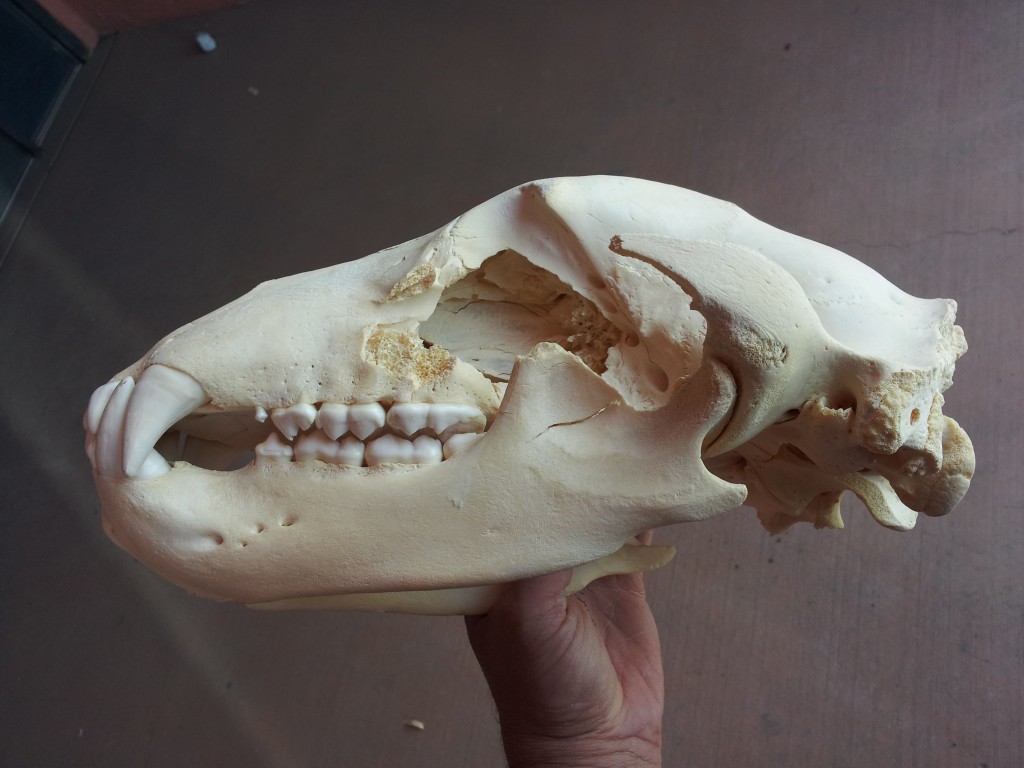This post originally appeared March 7, 2013.
In the mail yesterday I received a grizzly bear skull from an acquaintance and taxidermist in Soldotna, Alaska. Expertly cleaned down to chalk-white bone and glistening, thumb-sized canines, it was the size and general shape of a football, and as smooth as sanded wood. My friend had apologized ahead of time for there being a bullet hole.
Lifting the skull from its packaging, I expected to see a neat-dime-sized hole, a clean kill straight to the brain. Instead, there was a ragged gap as big as a fist through the left eye, pieces of jaw and skull exploded around it. Little flecks of bone salted out as I turned it for a closer look.
The angle of the shot looked like it could have been head-on, the bullet fired from only slightly to the side. But this wasn’t the shot that dropped the bear. This bullet had not actually penetrated the brain case. It had been stopped by exploded muscle and bone.
I wondered, had this been a charge, all slobber and paws? Or a curious 350-pound grizzly turning to study an intruder with a gun, then taking it right in the eye. I knew nothing about this bear. The only identification was a plastic tag looped through its one remaining zygomatic arch, which read, AK BGR 0202873.
As I held up this skull, I pictured around it the almost spherical head that had once been there, muscle-mass furrowed behind its muzzle, and two wooly mittens for ears. I saw dark eyes as small as buttons compared to the rest of its head. But I could not see if its coat had been cinnamon-colored or perhaps coffee-brown, if it had the scarred look of a fighter or was a loner who avoided confrontation. Teeth were sharp, not terribly worn, without a single sign of cavities. This had been a clean-living bear.
There would have been other bullets fired after the one to the eye. Perhaps many.
Were the shooter’s hands trembling? Was aim steely? I couldn’t tell range or caliber, if the shooter could feel the warmth of animal breath, or if the shot was from a rifle at some distance. So much was unknown, stories upon stories reduced to only their hardest, most resistant pieces. This is why I like skulls, why they decorate my shelves and at times clutter the dining room table. They are the beginnings of stories, and the ends of them. I have a collections casts of animals both extinct and living, and real skulls that I have found half-buried in forest loam. My acquaintance in Soldatna was clearing inventory, and I’d requested he send me whatever he didn’t need. So far I’d received a wolverine, a pair of space-ship-headed beaver skulls, juvenile black bear, and an assortment of deer, bobcat, lynx, even the paper-fragile skull of a duck.
What to do with a grizzly skull? I gave it to my desk, facing it toward me so when I look up I can see both sides of its life. One side is like cleanly polished marble; years of deep winter hibernation, summers of rivers and rivals. The other side, exploded, tells of a moment of flesh and blood to only be skinned and cleaned, where it now peers across books and papers at my mostly empty chair.
Photo: Craig Childs

Good one Craig.